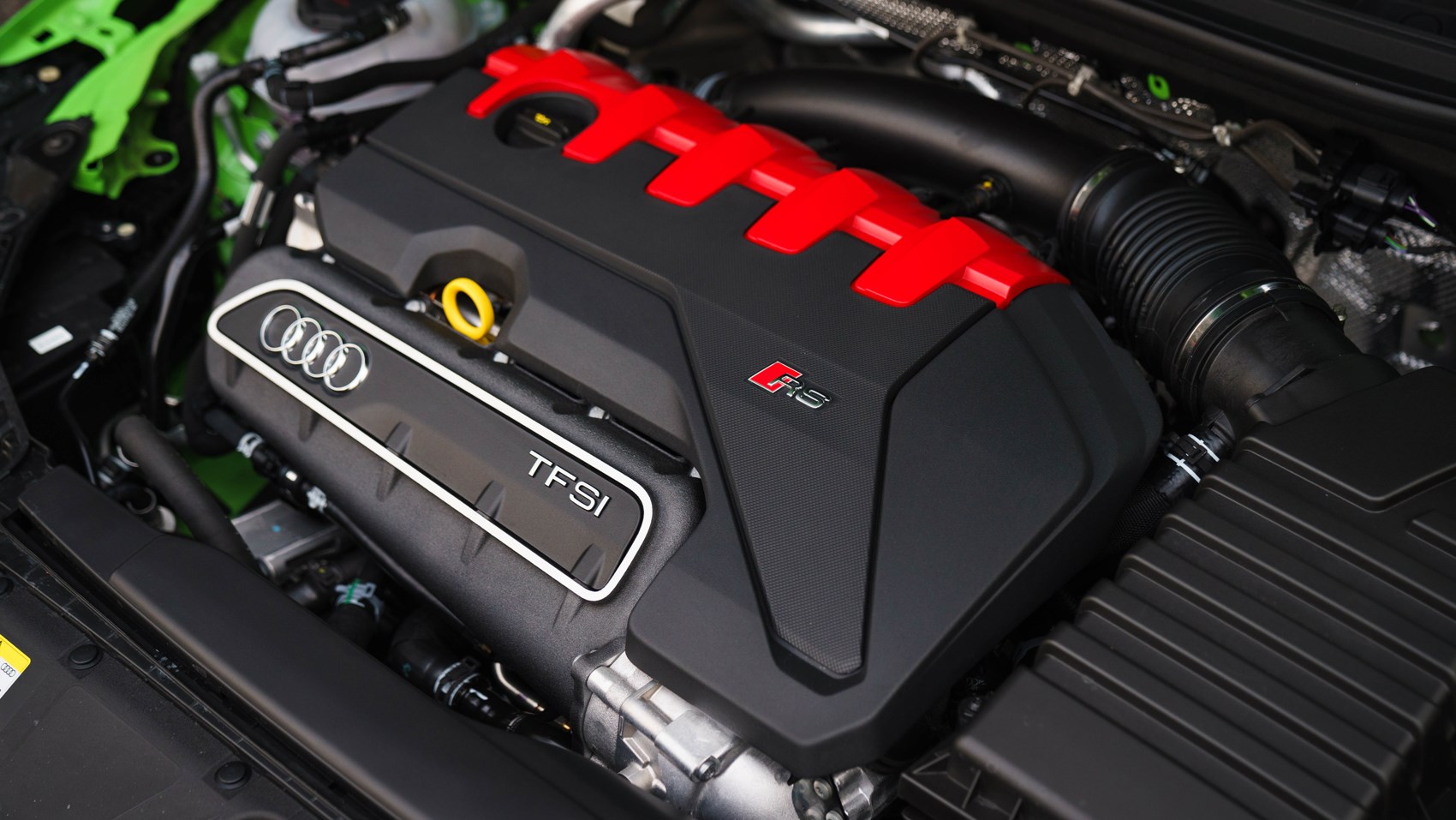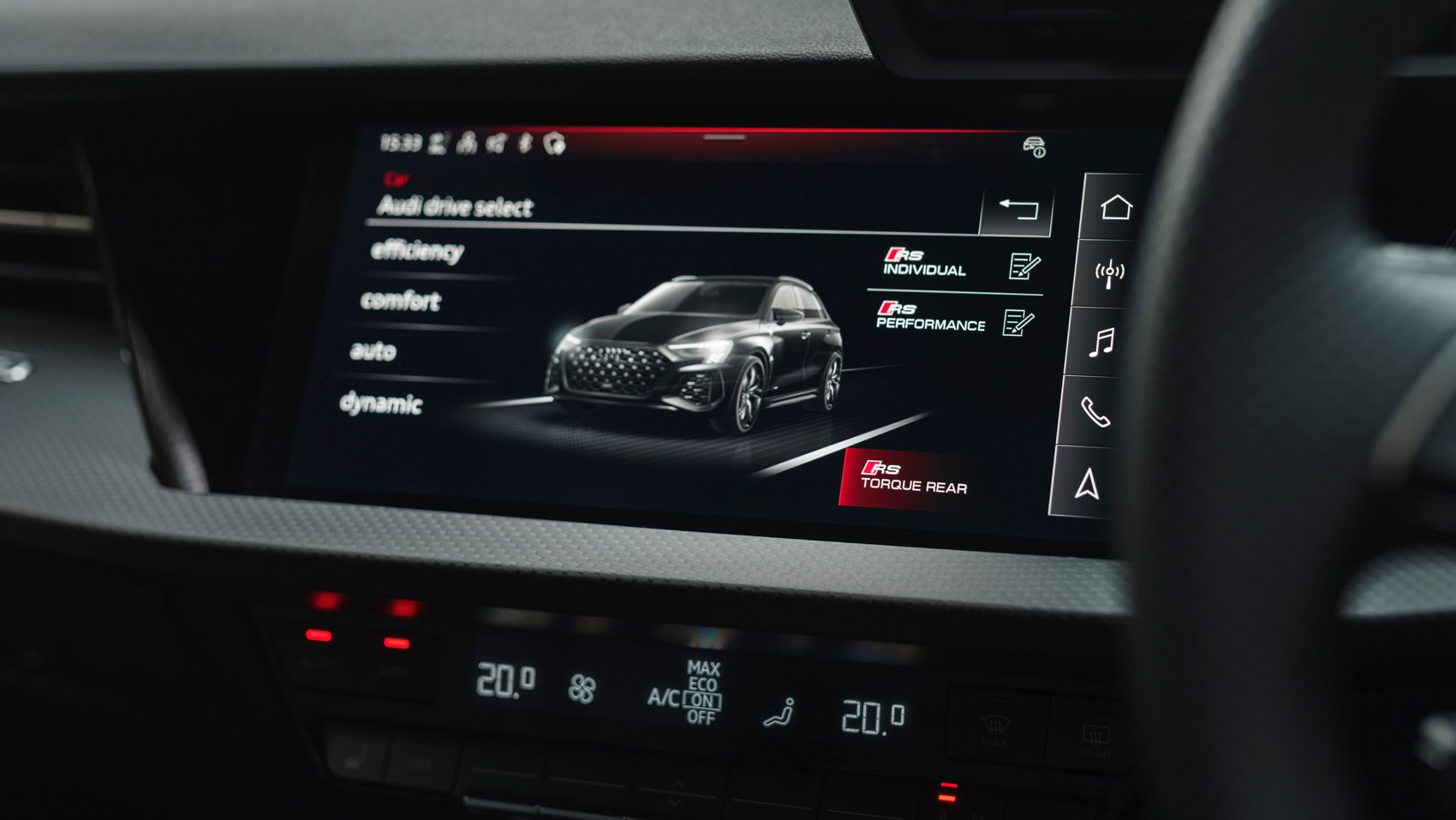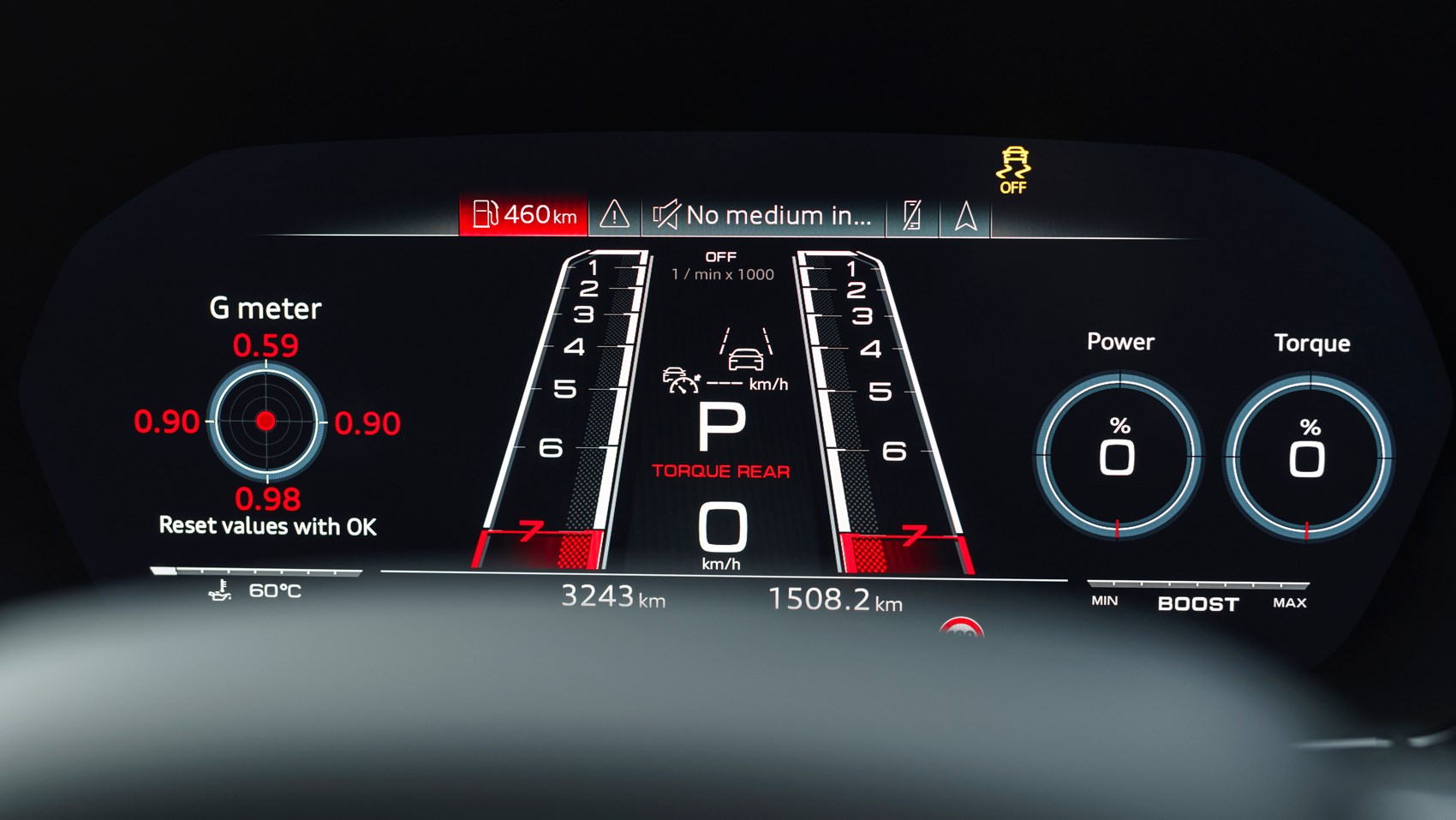► New 2021 Audi RS3 road (and track) test
► Rear axle Torque Splitter helps engagement
► 0-62mph in 3.8sec, 180mph
Audi’s hot, five-cylinder RS3 has reached its third generation, and it’s a bit of a gem. You can get it as a five-door Sportback hatch or a four-door RS3 saloon, offering you one of the most powerful hot hatches on sale or a sharp, super-powered baby exec. We’ve driven it on road and track in Greece on its international launch, as well as on UK roads.
What’s new?
Aside from the imposing bodywork and latest Virtual Cockpit Plus digital dashboard inside, the big news is a fresh rear axle with a Torque Splitter system able to divide twist precisely between each rear wheel for more agile handling. More on that in a bit.

It’s all controlled by the RS3’s new brain, the Modular Vehicle Dynamics Controller (MVDC), which networks the Torque Splitter with the drivetrain, suspension, wheel speed sensors and the various other electronic control units to ensure its chassis systems interact faster and more intelligently.
The Saloon’s shape lends itself well to the broad arches and it has a likeably boxy stance, although naturally loses a mite of rear headroom and practical carrying capacity compared with the £1000-cheaper Sportback.
Is it still a five-cylinder?
Happily, it’s still powered by the charismatic 2.5-litre five-cylinder engine, now with a new engine management system allowing greater boost pressure and in turn greater peak power and peak torque, arriving earlier and sticking around for longer. Peak power is 394bhp, from 5600-7000rpm, and peak torque 369lb ft from 2250-5600rpm.
The only gearbox option is a seven-speed dual-clutch, also linked with the MVDC.

What’s it like to drive, then?
First of all, it’s damn fast. That five-cylinder is an absolute weapon of an engine, providing what feels like continuous thrust from very low revs right up to the redline. Of course, that punch is accompanied by one of the most remarkable engine notes around.
The auto ‘box seems like it works better with you at higher speeds with more aggressive driving, with more sedate cruises through urban environments feeling a tad jerky at times. Even so, the shifts are seamless and instantaneous when you pull the (slightly plasticky) paddles.

With the adaptive dampers fitted (and ceramic brakes, which lop off 10kg of unsprung mass), ride quality is superb at urban speeds, and at speed on bumpy roads. But, even without the ceramic brakes, the RS3’s discs have some serious punch. A bit juddery on the motorway, however, even in Comfort mode – although that might be down to uneven tyre wear, as the saloon we spent the majority of time in had been driven hard on track previously. An RS3 Sportback we drove later had a much smoother motorway ride. There’s only 5kg between the Sportback and Saloon, at 1570kg and 1575kg respectively.
The RS3 feels a lot lighter than it really is, however. At all times it feels up on its toes and eager to change direction. That’s partly thanks to the well-resolved damping and the very quick steering requiring little lock for tight corners, but a big portion of praise goes to the Torque Splitter and MVDC.

A tonne and a half of all-wheel-drive passenger car might reasonably be expected to understeer, particularly under power, but the new RS3 changes direction very positively. On a smooth downhill stretch of mountain road, with left-right-left S-bends, you can feel the Splitter actively shuffling torque to the outside rear wheel, helping to drive the car around the corner and keep a tight line.
How does this Torque Splitter work?
Where the propshaft would ordinarily meet a differential at the rear, it instead has its drive taken off at 90 degrees to the rear wheels by a T-junction of gears. At each side, there is an electronically controlled multi-disc clutch unit. The Torque Splitter’s electronic brain, networked with the MVDC, then chooses how much torque is metered out to each rear wheel via the clutches.
If the car is in a long left-hand bend, for example, it apportions more torque to the right rear wheel, which is carrying the greater load, and less to the left, to help trim the car’s line. If the car then hits a slippery patch and starts to slide at the rear, it swiftly shuffles torque to the inside wheel, helping to pull the car straight.

Apart from shuffling torque side to side at the rear, the RS3 also apportions drive front to rear. In gentle driving, it’s predominantly front-wheel drive, and up to 50% of total torque can be sent to the rear when demanded.
The side-to-side rear Torque Splitter is in play at all times, but its behaviour depends on which driving mode you’re in. As well as the usual drive Efficiency (fuel-sipping throttle map), Comfort (light-steering, soft dampers, front-biased torque split), Auto (torque split evenly between the axles) and Dynamic (far more rear-biased) drive modes, the RS3 has three additional handling modes on top:
- RS Performance (for neat, tidy, fast-lapping track work)
- RS Individual (a pick and mix of settings for the torque splitter, powertrain, steering weight and suspension stiffness)
- RS Torque Rear (for deliberate drifting – intended only for use off the public road).
Drifting, you say?
Yep: in Torque Rear mode, the Splitter can direct as much as 100% of the rear axle’s torque to the outside wheel to help get a drift going, and then juggles it side to side to keep the slide going while you do the same with the steering and throttle pedal.
Audi set up a figure-of-eight course on private land for us to have a go. Be too heavy-handed with entry speed and you can end up with embarrassing understeer but keep the weight on the nose, be brutal with the throttle pedal in second gear and hey presto – we’re powersliding.
Audi’s engineers’ advice is to do it the classical way – try and move the steering wheel as little as possible and use your right foot to control the car’s angle – but I find myself keeping the throttle hard down and adding or subtracting lock to keep the slide going. It feels odd, and a different experience from that of a regular rear-wheel-drive sports car, albeit slightly more natural than the system in the most recent Ford Focus RS. It’s hilarious fun and I can’t stop grinning, but I wouldn’t want to try it on the road away from this vast sea of consequence-free tarmac. Nor would I want to pay for the tyres; the rears are now slicks and the rear wheel arches are trailing streamers of spent rubber. That was an expensive six minutes.
Isn’t this all a bit similar to the system in the VW Golf R – and the Ford Focus RS, for that matter? Similar hardware to the Golf R but very different in operation, thanks to the MVDC, Audi chassis development engineer Meic Diessner tells us. It differs from the GKN Twinster set-up in the most recent Ford Focus RS too, he says, in that the rear axle is not geared up to a different ratio from the rest of the driveline to help instigate a slide.
Any downsides?
The auto transmission can be lethargic to respond unless you’re in the more aggressive Dynamic or RS Performance drive modes, and the turbocharged throttle response likewise. That’s despite the new software enabling peak power and peak torque to arrive sooner in the rev range.

The engine still makes an evocative sound but even with the sports exhaust system, it’s rather muted. Active flaps within the exhausts are fully and constantly variable (the old RS3’s flaps were a switch, all the way open, or all the way closed) and that has in theory opened up a wider vocal range but it could bear to be louder still.
The optional ceramic brakes’ initial bite can be a little bit difficult to modulate on the road, and they can get a little squeaky after hard use.
And, as of early 2023, the RS3 is currently off sale. Demand is high for this potent new model, so Audi is focusing on clearing its existing orders before adding on new ones.
Verdict
The Audi RS3 is more engaging than ever. It feels far less inert than previous RS Audi models, largely thanks to its well-tuned suspension and the neatly integrated rear Torque Splitter system.
If the principle reason for buying an RS3 used to be its engine and its image, it now has far more to recommend it from a handling and engagement point of view now, too.